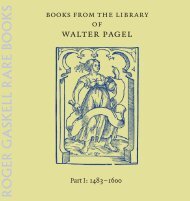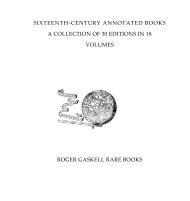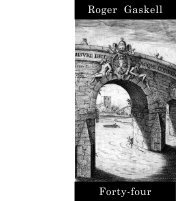pdf - Roger Gaskell Rare Books
pdf - Roger Gaskell Rare Books
pdf - Roger Gaskell Rare Books
You also want an ePaper? Increase the reach of your titles
YUMPU automatically turns print PDFs into web optimized ePapers that Google loves.
ROuSSET, François (1535–1590 or later)<br />
Exercitatio medica assertionis novae veri usus anastomoseon<br />
cardiacarum foetus ex utero materno trans ipsas trahentis aërem<br />
internum in suos pulmones motus respiratorii (contra communem<br />
opinionem) tu[n]c non expertes, & illum cordi eum appetenti, suique<br />
etiam tunc micantis motus compoti praeparaturos.<br />
Paris: excudebat Dionysius Duvallius, sub pegaso, in vico Bellovaco,<br />
1603.<br />
8vo: 6<br />
* A–M4 N2 (blank * 6), 56 leaves, pp. [12] 100 (i.e. 98) [2],<br />
including the blank. Fleuron device on titlepage, woodcut headpieces<br />
and initials.<br />
Waller 8261.<br />
167 x 100mm. Light soiling to titlepage of Wrst work.<br />
Binding: Contemporary English calf, blind ruled borders to sides and<br />
spine compartments, later lettering piece. Surface of leather very worn,<br />
head and tailcaps chipped, joints cracked at head and foot.<br />
Provenance: Joseph Fenton (c. 1565/70–1634) with his signature, motto<br />
‘Sors mea mors’ and number ‘78’ in a rectangle on the titlepage; large<br />
letter L stamped in gilt in upper spine compartment; pencil inscription<br />
‘From the Bibliotheca Philippica’.<br />
First edition.<br />
A fascinating volume combining two exceptionally rare works, the Wrst the<br />
only work of an English natural philosopher who was a supporter of Giordano<br />
Bruno. It was published in Paris the year after Bruno was burnt at the stake.<br />
The second work is the last work of the French physician François Rousset.<br />
The volume was owned by a contemporary English surgeon, and probably<br />
bound for him. Fenton’s library has only recently come to light and is<br />
important for adding to the growing body of evidence that the the stereotype<br />
of the uneducated surgeon (unable to read Latin) needs to be treated with<br />
caution. The two works demonstrate the wide range of his interests, perhaps<br />
more so than the selection from his library made by Sir Hans Sloane (now in<br />
the British Library) would suggest.<br />
Hill, Philosophia Epicurea (1601). Hill was a graduate, and for a short<br />
time a fellow, of St John’s College, Oxford. He declared himself a disciple of<br />
Giordano Bruno whose wellremembered visit to the university had taken<br />
place in 1583, four years before Hill matriculated. Hill supported the main<br />
cosmological ideas of Bruno – heliocentrism, atomism, the eternity of matter,<br />
the inWnity of the universe and the plurality of worlds. After he left Oxford,<br />
probably on account of his conversion to Catholicism, Hill became a member<br />
of the circle of Henry Percy, ninth earl of Northumberland, the ‘wizard earl’.<br />
Northumberland was himself interested in Bruno and had many of Bruno’s<br />
works in his large library.<br />
Hill’s work was published in Paris where he had Xed, perhaps taking fright<br />
after learning that the Earl of Essex was plotting to seize Lundy Island and<br />
declare himself heir to the throne.<br />
‘Hill’s Philosophia epicurea, a sequence of 509 propositions in natural







